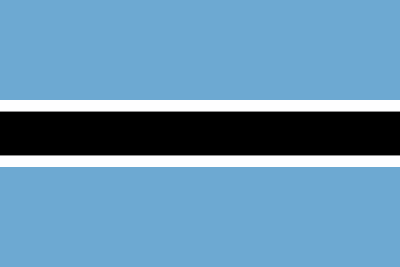Botswana's glorious colors: exploring the flag and its symbols
The flag of Botswana is a vibrant and meaningful representation of the country's rich history, culture and aspirations. Adopted on September 30, 1966, soon after Botswana gained independence from British colonial rule, the flag has become an important national symbol. Its design includes various elements that reflect Botswana's values, natural resources and commitment to progress. In this article, we will explore the significance of the Botswana flag, its colours, patterns and the stories they tell.
Original Design:
The flag of Botswana features a prominent blue field with a horizontal black stripe in the center. The black stripe is bordered by two thin white stripes, one above and one below. In the upper left corner, on the hoist side, sits a vertical stripe of white and black interlocking triangles.
Symbolic Interpretation:
a) Blue Zone:
The blue field of the Botswana flag represents water, a precious resource in the country's largely arid landscape. It symbolizes the importance of water in sustaining life, agriculture and overall development of the nation. Furthermore, the blue color symbolizes the harmony, unity, and peace that Botswana seeks to maintain within its borders.
b) Black Bar:
The central black stripe represents the people of Botswana, showing their collective strength and determination. It symbolizes the country's commitment to democracy, justice and equal rights for all its citizens.
c) White stripes:
The two thin white stripes next to the black stripe symbolize peace and honesty, which are the core values of Botswana. They represent the peaceful coexistence of diverse ethnic and racial groups within the country's borders.
d) Vertical Triangle:
The vertical stripe of white and black interlocking triangles on the wavy side represents Botswana's cultural heritage. The white triangle symbolizes purity, while the black triangle symbolizes the determination of the people to protect and preserve their heritage and traditions.
Historical significance:
The Botswana flag was designed by University College London student Mpho Mashabele, who won a nationwide competition to create the flag. The design expressed the aspirations of the newly independent nation and its desire to chart a path of progress while remaining true to its cultural roots.
The colors and patterns of the flag draw inspiration from traditional Botswana shields used by warriors for protection and identification. This association with the country's historical symbols serves as a reminder of Botswana's glorious past and its continued resilience in the face of challenges.
The flag of Botswana stands as a testimony to the country's journey towards independence and commitment to democratic values, cultural heritage and peaceful coexistence. Its colors and patterns match the aspirations of the Batswana people, reflecting their connection to the land, water and the principles that guide their nation.
As Botswana continues to grow and develop, its flag remains a powerful symbol that unites its citizens and represents the country on the global stage. It is a source of pride, unity and a constant reminder of the values Botswana holds dear – peace, progress and the preservation of its rich cultural heritage.
Botswana, located in southern Africa, has a diverse culinary scene that reflects the country's traditional ethnic groups and natural resources. Botswana's cuisine is known for its hearty and delicious dishes, which often include local ingredients such as meat, sorghum, millet and wild fruits. Here are some notable foods from Botswana:
foods of Botswana
- Seswa: Considered the national dish of Botswana, seswa is a savory meat stew made from slow-cooked, tender beef or goat. The meat is usually boiled until tender and then sliced before being served with a thick sauce. Seswa is usually enjoyed with pap (maize meal) or bogobe (sorghum or maize porridge).
- Wetkoek: Wetkoek is a popular street food in Botswana. It consists of deep fried dough balls which are light and fluffy on the inside and crispy on the outside. Vetkoek can be enjoyed plain or stuffed with various fillings such as minced meat (ground beef), cheese, or jam.
- Morogo: Morogo refers to a variety of indigenous, wild leafy greens that are a staple in Botswana cuisine. These green vegetables are often collected from the forest or grown in home gardens. Morogo is usually boiled or fried with onions, garlic and tomatoes and served as a side dish with main meals.
- Seswa and pap/bogobe: As mentioned earlier, seswa is often combined with pap (maize meal) or bogobe (sorghum or maize porridge). These staple carbohydrate dishes are prepared by cooking the grains in boiling water until they thicken to a porridge-like consistency. The pap or bogob is then shaped into a ball or served as a soft accompaniment to various stew and meat dishes.
- Mopane Worms: Mopane Worms are a unique and protein-rich dish in Botswana. These large caterpillars, harvested from mopane trees, are sun-dried or smoked before being cooked. They can be enjoyed in a variety of ways, such as fried, boiled or added to stews. Mopane worms are often cooked with spices and are known for their crispy texture.
- Bogobé Jwa Lerotse: This traditional dish is made from sorghum or maize meal and cooked like papa. Bogobé zwa lerotse is particularly associated with the Tswana ethnic group and is usually enjoyed with various meat or vegetable stews.
- Dikgobe: Dikgobe is a hearty and nutritious dish made from a combination of legumes like cowpea, sugar beans and groundnut. The beans are cooked with vegetables such as potatoes, onions and tomatoes, resulting in a delicious stew. Dikgobe is often served with pap or rice.
- Marula fruit: The marula fruit, native to Botswana, is highly prized for its sweet and tangy flavor. The fruit is used to make a variety of products including jams, jellies, liqueurs and even wine. It is also eaten fresh and is a popular ingredient in sweets.


Comments
Post a Comment